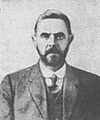Dame Blanche (resistance) facts for kids
La Dame Blanche (which means "The White Lady" in French) was the secret name for a spy network during World War I. This group worked underground in Belgium, which was controlled by Germany at the time. The name "White Lady" came from an old German story. This story said that a woman dressed in white would appear to announce the end of the Hohenzollern royal family.
This secret network gathered important information. They watched the railway system very closely. By doing this, they could find out where German troops were moving. This information was very helpful to the Allied forces.
Contents
What Was La Dame Blanche?
La Dame Blanche was a brave group of spies. They helped the Allies during World War I. Their main job was to collect secret information. This information was about the German army. They focused on German troop movements in Belgium.
How the Network Started
The Dame Blanche network began in 1916. It was started by a man named Walthère Dewé. He was an engineer in Brussels, Belgium. He worked for a company that handled telegraphs and telephones.
Dewé decided to create the network after a sad event. His cousin, Dieudonné Lambrecht, had also started a spy group. But Lambrecht was caught and executed. To save his cousin's group, Dewé took charge. He renamed it Dame Blanche and worked with his friend Herman Chauvin.
Spying for the Allies
At first, La Dame Blanche worked with the British military intelligence service. This connection was made through a place called Folkestone in England.
However, German spies tried to get into the network. These agents worked for Colonel Walter Nicolai. Because of this danger, La Dame Blanche changed its main contact. They then worked with the British Secret Service in Rotterdam, Netherlands. Their new helper there was Captain Henry Landau.
Important Connections
After the war, the head of the British Secret Service, Mansfield Smith-Cumming, praised Dame Blanche. He believed they provided a huge amount of information. He estimated that they supplied about 70 percent of all military intelligence. This was not just from Belgium. It was from all over the world that the Allies gathered information.
Who Were the Agents?
By the end of World War I, La Dame Blanche had many agents. About 1,300 people were part of the network. They covered all of German-controlled Belgium. They also worked in northern France. Through working with Louise de Bettignies' network, they even covered Luxembourg.
This network was special because many women were members. About 30 percent of all the agents were women. They played a very important role in gathering information.
A Lasting Legacy
Years later, during World War II, Germany occupied Belgium again. Walthère Dewé used his past experience from Dame Blanche. He started a new spy network called Clarence. Some former members of Dame Blanche joined this new group.
Sadly, Walthère Dewé was killed in January 1944. He was trying to avoid being captured by the Germans.
Today, there is a monument to honor the Dame Blanche resistance group. It is the Chapelle Saint-Maurice (mémorial Walthère Dewé). You can find it at Rue Coupée 94, Liège, Belgium.
Images for kids




